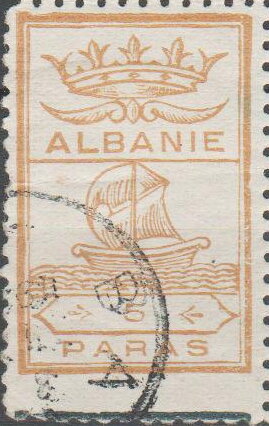Stamp: Crown over ship (Albania 1914)
Crown over ship (Albania 1914)
01 January (Albania ) within release Crown over ship goes into circulation Stamp Crown over ship face value 5 Turkish para
| Stamp Crown over ship in catalogues | |
|---|---|
| Colnect codes: | Col: AL 1914-01 |
Stamp is square format.
Bogus issue, believed to originate from FranceAlso in the issue Crown over ship:
- Stamp - Crown over ship face value 5;
- Stamp - Crown over ship face value 10;
- Stamp - Crown over ship face value 20;
- Stamp - Crown over ship face value 80;
- Stamp - Crown over ship face value 5;
- Stamp - Crown over ship face value 10;
- Stamp - Crown over ship face value 20;
- Stamp - Crown over ship face value 40;
- Stamp - Crown over ship face value 80;
|
Data entry completed
50%
|
|
|---|---|
| Stamp Crown over ship in digits | |
| Country: | Albania |
| Date: | 1914-01-01 |
| Emission: | Cinderella |
| Format: | Stamp |
| Face Value: | 5 Turkish para |
Stamp Crown over ship it reflects the thematic directions:
In British heraldry, a coronet is any crown whose bearer is less than sovereign or royal in rank, irrespective of the crown's appearance. In other languages, this distinction is not made, and usually the same word for crown is used irrespective of rank (German: Krone, Dutch: Kroon, Swedish: Krona, French: Couronne, etc.) In this use, the English coronet is a purely technical term for all heraldic images of crowns not used by a sovereign, and implies nothing about the actual shape of the crown depicted. A Coronet is another type of crown, but is reserved for the lower ranks of nobility like Marquesses and Marchionesses, Earls and Countesses, Barons and Baronesses, and some Lords and Ladies. The specific design and attributes of the crown or coronet signifies the hierarchy and ranking of its owner.
A modern sailing ship or sailship is any large wind-powered vessel. Traditionally a sailing ship (or simply ship) is a sailing vessel that carries three or more masts with square sails on each. Large sailing vessels that are not ship-rigged may be more precisely referred to by their sail rig, such as schooner, barque (also spelled "bark"), brig, barkentine, brigantine or sloop. There are many different types of sailing ships, but they all have certain basic things in common. Every sailing ship has a hull, rigging and at least one mast to hold up the sails that use the wind to power the ship. The crew who sail a ship are called sailors or hands. They take turns to take the watch, the active managers of the ship and her performance for a period. Watches are traditionally four hours long. Some sailing ships use traditional ship's bells to tell the time and regulate the watch system, with the bell being rung once for every half hour into the watch and rung eight times at watch end (a four-hour watch). Ocean journeys by sailing ship can take many months, and a common hazard is becoming becalmed because of lack of wind, or being blown off course by severe storms or winds that do not allow progress in the desired direction. A severe storm could lead to shipwreck, and the loss of all hands. Sailing ships are limited in their maximum size compared to ships with heat engines, so economies of scale are also limited. The heaviest sailing ships (limited to those vessels for which sails were the primary means of propulsion) never exceeded 14,000 tons displacement. Sailing ships are therefore also very limited in the supply capacity of their holds, so they have to plan long voyages carefully to include many stops to take on provisions and, in the days before watermakers, fresh water.
A ship is a large watercraft that travels the world's oceans and other sufficiently deep waterways, carrying passengers or goods, or in support of specialized missions, such as defense, research and fishing. Historically, a "ship" was a sailing vessel with at least three square-rigged masts and a full bowsprit. Ships are generally distinguished from boats, based on size, shape and load capacity.



